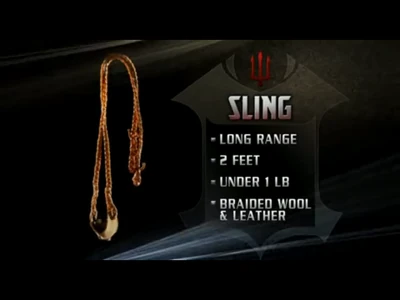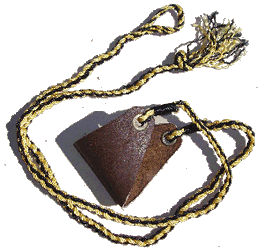(File added via image placeholder) |
(→Trivia) |
||
| (46 intermediate revisions by 17 users not shown) | |||
| Line 1: | Line 1: | ||
| ⚫ | |||
| ⚫ | |||
| + | |||
| ⚫ | |||
==Description== |
==Description== |
||
| − | The sling is simply two cords (in this case, braided wool) attached to a small pouch. The projectiles used were most commonly stones, or sometimes lead weights. |
+ | The sling is simply two cords (in this case, braided wool) attached to a small pouch. One of the cords ends in a loop which fits over the finger, while the other ends in a knot which is held. The projectiles used were most commonly stones, or sometimes lead weights. |
==Use== |
==Use== |
||
| − | The sling was a low-status weapon, cheap and easy to make. It was commonly used for hunting, fending off wild animals, and warfare. The projectile is placed into the pouch and the user swings it around several times. |
+ | The sling was a low-status weapon, cheap and easy to make. It was commonly used for hunting, fending off wild animals, and warfare. The projectile is placed into the pouch and the user swings it around several times. The cords are released and the projectile is launched forward. Greco-Roman slingers could wear their slings as clothing when not in battle. [https://youtu.be/covH4voKukw?t=41] |
| + | |||
| + | Because of its simplicity, the sling was one of the most commonly used weapons in the ancient world, and some archeologists have discovered modified stones made by stone-age cavemen: implying that slings were one of the earliest manmade weapons to be used. Virtually every ancient army used slingers to some degree. The most famous account of the sling's use in ancient warfare is from the Holy Bible. David, an unarmored shepherd boy, used the sling to kill the Philistine giant Goliath with a single shot to the forehead, demonstrating that while it may be a low-status weapon, in the hands of an expert, it was not to be underestimated. |
||
| + | |||
| + | Slings would be used throughout the Greek and Roman empires. Revolts (especially those led by slaves, Gladiators and Celts) had the impoverished warriors rely on the cheap sling. Conventional armies successfully used slings to repel cavalry charges. Slings also has about twice the range as bows; with Greek slingers having a maximum range of 300 meters and bows 150 meters. While bows are more precise; a volley aiming against dense army divisions doesn't need precision against such a massive target. Slingers from the island of Rhodes were considered to be very skilled compared to other Greeks; so much so that Xenophon asked his Rhodian hoplites to be slingers instead. The Spanish Balearic Islands were also famous for the skill of their slingers; being employed as mercenaries by the empires of Carthage and Rome. |
||
| + | |||
| + | Slings existed in the middle ages but the practice of using large numbers of slingers as a unit in battle faded as archers and crossbowmen began to dominate the battlefield, while advances in steel armor made the light sling more ineffective. Spain and Portugal were exceptions, as the Moorish armies they fought against during the Reconquista rarely used heavy armor in combat. |
||
| + | |||
| + | [[Tematlatl|Pre-Colombian Central and South American armies frequently used slingers.]] |
||
| + | |||
| + | As muskets appeared, the art of slinging was reduced to fending off wolves in farms, and even then the gun replaced the sling for civilian use. In modern times, it is still used by rioters, survivalists, nomads, farmers (to fend off wild animals) or competitive slingers: although the [[Slingshot]] is considered to be more reliable and accurate. |
||
| + | |||
| + | ==In Show== |
||
| + | The sling has been used several times in show, however it is constantly paired up against the bow, to which it always comes out being an inferior weapon, having poorer range, accuracy and killing power. |
||
| + | |||
| + | ==Stats== |
||
| + | *Length: 2 feet (Gladiator), 5 feet (Celt) |
||
| + | *Weight: Under 1 pound |
||
| + | *Composition: Braided wool and leather |
||
| + | *Range: 220 yards (Celt) |
||
| + | *Stone length: 3 inches |
||
| + | |||
| + | ==Trivia== |
||
| + | *In a manner similar to the tale of David and Goliath; the Irish-Celtic myth of the Mythological Cycle tells of a slinger named Lugh. A giant cyclops named Balor had a magical eye that had a toxic glare that would drive warriors mad or engulf them in fire. Lugh used a sling to destroy the eye, winning the battle. |
||
| + | *The world record distance for a sling was 437.10 m: using a 51.0 in long sling and a 52 g ovoid stone. |
||
| + | *Modern armies used slings to throw grenades. |
||
| + | *Documentary of Balearic Slingers [https://www.youtube.com/watch?v=3uDtrwNY0Zk] |
||
| + | ==Gallery== |
||
| − | In Celtic warfare, slings were used over more advanced and accurate projectile weapons because the Celts saw long-range combat as being cowardly. |
||
| ⚫ | |||
| + | [[Category:Weapons]] |
||
| + | [[Category:Ancient Weapons]] |
||
| + | [[Category:Slings]] |
||
| + | [[Category:Projectile Weapons]] |
||
| + | [[Category:Long Ranged Weapon]] |
||
| + | [[Category:Weapons Used By Multiple Warriors]] |
||
| + | [[Category:Stone Age Weapons]] |
||
Revision as of 11:47, 10 August 2020
The Sling is an ancient projectile weapon used to hurl stones or weights long distances. It was the Long-Range weapon of the Gladiator and the Celt. Another version of the sling, the Tematlatl, was used by the Aztec Jaguar.

Description
The sling is simply two cords (in this case, braided wool) attached to a small pouch. One of the cords ends in a loop which fits over the finger, while the other ends in a knot which is held. The projectiles used were most commonly stones, or sometimes lead weights.
Use
The sling was a low-status weapon, cheap and easy to make. It was commonly used for hunting, fending off wild animals, and warfare. The projectile is placed into the pouch and the user swings it around several times. The cords are released and the projectile is launched forward. Greco-Roman slingers could wear their slings as clothing when not in battle. [1]
Because of its simplicity, the sling was one of the most commonly used weapons in the ancient world, and some archeologists have discovered modified stones made by stone-age cavemen: implying that slings were one of the earliest manmade weapons to be used. Virtually every ancient army used slingers to some degree. The most famous account of the sling's use in ancient warfare is from the Holy Bible. David, an unarmored shepherd boy, used the sling to kill the Philistine giant Goliath with a single shot to the forehead, demonstrating that while it may be a low-status weapon, in the hands of an expert, it was not to be underestimated.
Slings would be used throughout the Greek and Roman empires. Revolts (especially those led by slaves, Gladiators and Celts) had the impoverished warriors rely on the cheap sling. Conventional armies successfully used slings to repel cavalry charges. Slings also has about twice the range as bows; with Greek slingers having a maximum range of 300 meters and bows 150 meters. While bows are more precise; a volley aiming against dense army divisions doesn't need precision against such a massive target. Slingers from the island of Rhodes were considered to be very skilled compared to other Greeks; so much so that Xenophon asked his Rhodian hoplites to be slingers instead. The Spanish Balearic Islands were also famous for the skill of their slingers; being employed as mercenaries by the empires of Carthage and Rome.
Slings existed in the middle ages but the practice of using large numbers of slingers as a unit in battle faded as archers and crossbowmen began to dominate the battlefield, while advances in steel armor made the light sling more ineffective. Spain and Portugal were exceptions, as the Moorish armies they fought against during the Reconquista rarely used heavy armor in combat.
Pre-Colombian Central and South American armies frequently used slingers.
As muskets appeared, the art of slinging was reduced to fending off wolves in farms, and even then the gun replaced the sling for civilian use. In modern times, it is still used by rioters, survivalists, nomads, farmers (to fend off wild animals) or competitive slingers: although the Slingshot is considered to be more reliable and accurate.
In Show
The sling has been used several times in show, however it is constantly paired up against the bow, to which it always comes out being an inferior weapon, having poorer range, accuracy and killing power.
Stats
- Length: 2 feet (Gladiator), 5 feet (Celt)
- Weight: Under 1 pound
- Composition: Braided wool and leather
- Range: 220 yards (Celt)
- Stone length: 3 inches
Trivia
- In a manner similar to the tale of David and Goliath; the Irish-Celtic myth of the Mythological Cycle tells of a slinger named Lugh. A giant cyclops named Balor had a magical eye that had a toxic glare that would drive warriors mad or engulf them in fire. Lugh used a sling to destroy the eye, winning the battle.
- The world record distance for a sling was 437.10 m: using a 51.0 in long sling and a 52 g ovoid stone.
- Modern armies used slings to throw grenades.
- Documentary of Balearic Slingers [2]
Gallery
